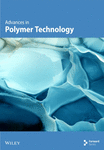Abstract
Melting in screw extruders has been studied extensively, starting with the experimental studies of Maddock and Street in the 1950s. These workers observed a melting model with the solid particles all clumped together in a solid bed. A thin melt film separated the solid bed from the extruder barrel; most melting took place between the solid bed and the melt film. This melting model is termed the contiguous solids melting model, CSM; it is the model most often observed in single screw extruders. It was first analyzed theoretically by Tadmor in the early 1960s. Another type of melting that has been observed by several workers has separate, solid particles floating in a melt matrix. This melting model is termed dispersed solids melting, DSM; it has been observed in twin screw extruders, reciprocating single screw compounders, and some regular single screw extruders. It has been observed experimentally that melting through DSM occurs much more efficiently than through CSM. However, there has been little work published on a quantitative description of dispersed solids melting. Here the theory of CSM as well as DSM is developed with closed-form analytical solutions. The melting characteristics of the two models are compared. It is shown that dispersed solids melting can be substantially more efficient than contiguous solids melting. This opens up interesting areas of investigation. © 1996 John Wiley & Sons, Inc.




